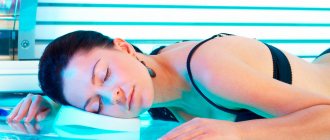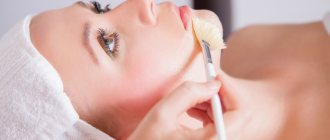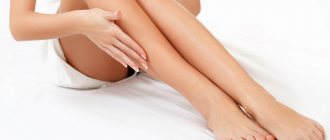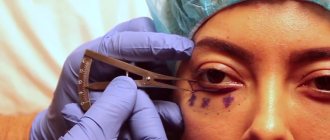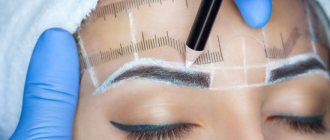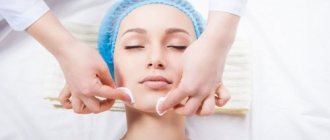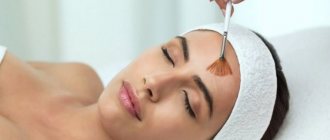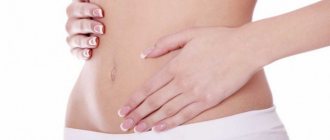According to cosmetologists, after tanning you will have to temporarily change your self-care routine and give up peeling. This is especially true for medium, deep and with the use of aggressive abrasive particles. After sunbathing, the skin is in a state of stress, it is dry, thin and very sensitive. Recovery time varies from person to person and is also influenced by the place of rest.
Marine ultraviolet radiation acts quite aggressively on the skin. He destroys her protective barriers. After the beach, the skin is always inflamed and slightly red. As a result of the burn, the dermis is very susceptible to all kinds of procedures. In this case, even products for sensitive, delicate and problematic skin will not be suitable.
You should start peeling the dermis after sunbathing at sea only when it has completely recovered . She should calm down, during which time all redness and inflammation will subside. Peeling should disappear, since it cannot be removed artificially. For some, the recovery period may take about a week, for others it will take almost a month.
The deeper the peeling, the more time should pass between the procedure and tanning . For salon treatments (ultrasound, medium, deep) it will take about three weeks.
As for home treatments such as coffee, oatmeal, sea salt, enough time should also pass. They have sharp edges that mechanically clean the surface of the skin. This effect is too aggressive for the irritated dermis.
It is especially not recommended to exfoliate between trips to the beach. This is dangerous for the health and beauty of the skin.
Ultraviolet radiation in a solarium is an even more aggressive factor for the skin . It greatly promotes the expansion of pores. After a course of solarium, she becomes very susceptible to various cosmetics and procedures.
done after 1-1.5 months , when the skin has completely recovered. Even after a superficial one, it’s worth waiting a couple of weeks. All this time it is better to make special moisturizing and regenerating masks.
The main condition for peeling after tanning is nutrition and hydration after the procedure . To do this, you need to use creams and balms with the maximum effect of restoring water balance, with vitamin E, group B. Moisturizing masks are also good.
After tanning, the skin dries out greatly, collagen and elastin fibers are destroyed. Therefore, peelings are needed for rejuvenation. They remove the top layer of skin, stimulate cell renewal, which ultimately stimulates the production of collagen and elastin. The dermis becomes smoother, softer, and fresher. Therefore, after recovery, it is even advisable to carry out procedures.
Hardware peeling with ultrasound or laser . Depending on the client’s age, you can choose:
- Light, superficial, eliminates dead skin cells. This is suitable for dry skin with flaking and roughness. It is usually performed with a laser to remove freckles, hyperpigmentation and small wrinkles. To level the relief, dermabrasion is used, which removes only the top layer of cells with special brushes.
- The middle one is suitable if deeper creases have intensified. It removes the top layer of the dermis - the papillary layer.
- Deep is performed to remove wrinkles and scars. He already removes two layers of the dermis - papillary and reticular. The first procedure allows you to evaluate a positive result.
Exfoliating after sunbathing will help tidy up your skin. It will make it more even and smooth.
Homemade peeling (scrub) for skin with anti-aging effects:
- With sugar. The product is combined with honey or natural yogurt and blended in a blender. The mixture should be applied to the skin, covered with film and left for half an hour. After rinsing with cool water, apply moisturizer.
- With coffee . The grains are crushed or brewed into a drink and then used. The scrub should be applied to the entire body within a few minutes. It helps fight cellulite.
- With sea salt. The crystals are ground in a blender to powder and mixed with citrus essential oil. Massage clockwise from bottom to top for 3-5 minutes.
Chemical peeling after tanning is carried out in a gentle manner. To do this, use acids with a concentration of no more than 30%. Externally, such peeling does not cause obvious damage, but it affects the deep layers of the dermis. Acids penetrate into the lower layers, where the synthesis of collagen and elastin fibers is accelerated, and the process of regeneration and rejuvenation is launched. Suitable for young dermis and those undergoing the first age-related changes.
The procedure can be carried out at home using various berries and fruits. Suitable: strawberries, kiwi, citrus fruits, apples, bananas, currants, raspberries. The products are cut into pieces or mashed into purees and applied to the face and body. Leave the masks on for 10-15 minutes. After rinsing, you should always apply a moisturizing or nourishing cream.
Cleansing peeling after tanning is carried out in the salon using acids. Pineapple and papaya enzymes remove the upper, keratinized layer of cells and normalize the functioning of the sebaceous glands. Glycolic, lactic and citric acids are used for peeling at a concentration of 15%. They act gently and do not cause negative consequences, cleanse pores, restore the protective barrier, and have a rejuvenating effect.
You should start the procedures with healthy skin. Peels should not be done if:
- Fever, chills, worsening viral or bacterial infection.
- The girl is pregnant or breastfeeding.
- There is an active inflammatory process on the skin, that is, acne and blackheads are visible.
- There is an exacerbation of dermatitis.
- With relapse of psoriasis.
- You are allergic to peeling components.
- A person undergoes rehabilitation after treatment for cancer.
Read more in our article about post-sun peeling.
Read in this article
What kind of peeling can you do at home?
Peeling can be done both in the salon and at home. The main condition is nutrition and hydration after the procedure. To do this, you need to use creams and balms with the maximum effect of restoring water balance, with vitamin E, group B. Moisturizing masks are also good.
After tanning, different types of peeling are performed. They are focused and deep.
Rejuvenating
After tanning, the skin dries out greatly, collagen and elastin fibers are destroyed. Therefore, peelings are needed to eliminate the first signs of aging. They remove the top layer of skin, stimulate cell renewal, which ultimately stimulates the production of collagen and elastin. The dermis becomes smoother, softer, fresher and glowing from within.
In-salon, hardware peeling with ultrasound or laser can help achieve a long-term effect. Depending on the client’s age, you can choose:
- Light, superficial, removes dead skin cells. This is suitable for dry skin with flaking, roughness, which has lost its shine and tone. It is usually performed with a laser to remove freckles, hyperpigmentation and small wrinkles. Dermabrasion is also used to smooth out the relief, which removes only the top layer of cells with special brushes.
- The middle one is suitable if deeper creases have intensified. It removes the top layer of the dermis - the papillary layer.
- Deep is carried out to remove deep wrinkles and scars. It already removes two layers of the dermis: papillary and reticular. Already the first procedure allows you to evaluate a positive result.
Exfoliating after sunbathing will help tidy up your skin. It will make it more even and smooth.
For young skin after sunbathing, rejuvenating peeling at home is suitable, since you only need to remove the surface layer of keratinized cells. Various scrubs are used for this:
- With sugar . The product is combined with honey or natural yogurt and blended in a blender. The mixture should be applied to the skin, covered with film and left for half an hour. After rinsing with cool water, apply moisturizer.
- With coffee . The grains are crushed or a drink is brewed with it, and then used. The scrub should be applied to the entire body within a few minutes. It also helps fight cellulite.
- With sea salt . The crystals are ground in a blender to powder and mixed with citrus essential oil. You need to massage clockwise from bottom to top for 3-5 minutes.
Watch the video about preparing a sugar body scrub:
Chemical
Chemical peeling after tanning is carried out in a gentle manner. To do this, use acids with a concentration of no more than 30%. Chemical peeling causes a reaction similar to a burn. The skin turns a little red, but calms down after a while.
Externally, such peeling does not cause obvious damage, but it affects the deep layers of the dermis. Acids penetrate into the lower layers, where the synthesis of collagen and elastin fibers is accelerated, and the process of regeneration and rejuvenation is launched.
The skin regains its tone and becomes more elastic. The color becomes healthier and more radiant. The skin surface becomes smoother. This chemical peeling is suitable for young dermis and those undergoing the first age-related changes.
The procedure can be carried out at home using various berries and fruits. Suitable: strawberries, kiwi, citrus fruits, apples, bananas, currants, raspberries. The products are cut into pieces or mashed into purees and applied to the face and body. These masks should not be left on for long: 10-15 minutes. After rinsing, you should always apply a moisturizing or nourishing cream.
Cleaning
Many have noticed that after sunbathing, the skin becomes oilier and the work of the sebaceous glands increases. The fact is that as a reaction to exposure to ultraviolet radiation, the layers of the epidermis thicken. The sebaceous ducts become clogged with sebum and dead cells. Therefore, inflammation often begins to appear after a vacation at sea.
Benefits of peeling
After peeling, the development of existing acne and the development of new ones stops. Acne scars are smoothed out, stagnant spots are eliminated. The skin becomes smoother and looks well-groomed.
The activity of the sebaceous glands decreases, the risk of comedones becomes less. During the peeling procedure, clogged pores are cleaned and partially narrowed.
Peeling activates restoration processes and stimulation of the production of your own collagen. Skin laxity and shallow wrinkles are eliminated. During rehabilitation, the skin self-renews and regains its former elasticity and smoothness.
Almond facial peeling is prohibited if you have an individual intolerance to the ingredients. Contraindications include periods of exacerbation of herpes and the presence of lesions on the skin.
Precautionary measures
You should start the procedures with healthy skin. Peels should not be done if:
- Fever, chills, worsening viral or bacterial infection.
- The girl is in an interesting position and is breastfeeding.
- There is an active inflammatory process on the skin, that is, acne and blackheads.
- There is an exacerbation of dermatitis.
- With relapse of psoriasis.
- You are allergic to peeling components.
- A person undergoes rehabilitation after treatment for cancer.
And here is more information about how to wash after sunbathing.
Peels should be performed on healthy and restored skin. It is also important to remember about contraindications. Properly selected peeling will benefit the skin. It will refresh and prolong your tan.
Mostly people with fair skin get freckles after sunbathing. They are visible on the body and face. If winter comes, freckles will mostly go away on their own. But how to clean your back, legs, and shoulders before the cold season?
In general, you can understand how to wash after sunbathing by the condition of your skin: it is burned and requires careful care. It is worth noting that you cannot swim immediately. How long after can you take a shower after the sun and solarium?
Typically, a brown spot is simply over-pigmentation of the skin. There are several reasons why it appeared on the body, as well as ways to get rid of it. But it is important to see a doctor to rule out cancer.
When wondering whether to wash after a solarium, whether it should be done immediately or after a while, it is important to understand why experts insist that it is not possible: under the influence of UV rays, the skin is injured, it needs time to recover. So you have a few hours to shower afterwards.
Quite often, both at sea and just when walking along the streets, it happens that your nose gets burned. In this case, first aid is the use of ointments for sunburn. You can also make compresses, and if your nose is peeling, then gentle peelings.
Before calculating the time when you can sunbathe after peeling, you need to take into account the strength of the impact of the cleansing on the skin. The period of limitation of sunbathing is directly proportional to the depth of penetration of peeling substances into the epidermis. That is, the more superficial the procedure, the faster the skin will recover, and, therefore, the opportunity to sunbathe. In this case, the method of obtaining a tan does not matter much.
List of contraindications
Despite all the advantages and positive results that peeling provides, it also has its contraindications.
The procedure is strictly contraindicated in the following cases:
- if your skin is excessively dehydrated and very dry;
- if there are formations such as nevi, papillomas or warts;
- if there are open wounds, as well as active viral or fungal diseases;
- for dermatitis;
- for diabetes mellitus;
- for oncological diseases;
- during pregnancy or while breastfeeding;
- if you have taken antibiotics (tetracyclines, isotretinoin or fluoroquinolones) within the last 6 months;
- with alcohol abuse;
- if you are planning trips to hot countries in the near future.
Thanks to this procedure, any woman, regardless of age, can rejuvenate her face and make it healthier and fresher. However, in order for the procedure to be for the benefit and not for the harm, weigh all its pros and cons in your case. Be sure to assess your overall health and take into account the skin’s ability to recover. You also need to be extremely careful when choosing one or another type of procedure. If you are planning to do it for the first time, it is better to go to a specialist rather than do it yourself.
Due to the fact that dead skin areas are removed by acting on them in one way or another, the skin becomes more “breathable”, the risk of pimples and blackheads is reduced, it looks fresh and has a healthy color.
What happens to the skin after peeling?
During peeling treatment, the upper layer of the epidermis is damaged. The renewed skin is so sensitive that any external influence on it is fraught with dermatological problems. During the period of regeneration of the epidermis, subject to mechanical or chemical cleansing, it should be protected from:
- Ultraviolet rays;
- Wind;
- Frost;
- Various types of pollution.
Among the above factors, ultraviolet radiation is especially dangerous, since under its influence the formation of pigmented areas occurs, which are subsequently quite difficult to get rid of. Therefore, until the skin’s protective reaction is restored after peeling treatment, you should completely avoid exposure to the sun or visiting a solarium.
The time for which sunbathing should be limited depends on the individual recovery of the skin and the aggressiveness of the procedure performed. In addition to pigmentation, unrestored epidermis exposed to sunlight is at risk of photoaging - intense drying of the skin to the state of “parchment paper”, the appearance of a wrinkled network.
IMPORTANT! Photoaging has no age limits. Even at 20 years old, you can get a lot of wrinkles if you don’t follow the rules of post-peeling care.
What types of peeling are there?
According to the method of exposure to the skin, all types of peeling can be divided into two groups: chemical and physical.
What is a chemical peel?
Chemical peels use liquids designed to remove dead cells from the surface of the skin to promote the growth of new cells. In this procedure, a chemical solution is applied to the skin, the top layer of the epidermis is “burned” and ultimately peeled off. New skin usually looks smoother.
There are many types of chemical peels based on the use of glycolic acid, salicylic acid, and mixtures of various ingredients. They differ in peeling depth and cosmetic result. Peeling not only induces the removal of old skin cells, but also stimulates collagen synthesis, which improves the structure and tone of the skin. The skin becomes elastic and its ability to retain moisture increases.
Chemical peels can be used to achieve the following goals:
- reduction of wrinkles under the eyes and around the mouth;
- correction of wrinkles caused by photodamage and aging;
- improving the appearance of soft scars;
- treating certain types of acne;
- reduction of age spots, freckles and hyperpigmentation.
Based on the depth of impact, there are superficial, medium and deep peelings. Superficial peeling acts in the upper layers of the epidermis. Medium peeling affects the entire epidermis, including the papillary dermis. Deep peeling can change the reticular dermis.
Superficial peeling
Superficial peeling is a mild chemical peel that is safe for use on all skin types. Typically, superficial chemical peels use mild reagents such as glycolic acid or AHA, glycolic acid. Since it only removes the most superficial layers of skin (the epidermis), this peel is ideal for smoothing fine lines and wrinkles, treating roughness, dryness, and photodamage. Treatment takes only 10-15 minutes. Results are visible immediately, although repeat treatments are recommended for best results.
Medium peeling
Medium (medium) peeling causes a second degree burn on the skin. A medium peel is used to remove cells in the upper and middle layers of the skin (upper dermis). A medium peel typically uses a peeling agent such as trichloroacetic acid, known as TCA. It penetrates deeper than glycolic acid, so TCA peeling can remove wrinkles, pigmentation and other skin imperfections. Skin recovery takes longer and can last up to six weeks.
Deep peeling
A deep peel is a harsh chemical peel that can penetrate multiple layers of skin and effectively treat problems such as deep wrinkles, severe age spots, sun spots, etc. For deep peeling, phenol is usually used. Deep peeling affects the skin down to the lower part of the dermis. After the procedure, some people experience swelling for two weeks, and redness of the skin can last up to three months.
A deep peel is a long-lasting “one-time” treatment, so it usually does not need to be repeated, unlike superficial and medium peels.
Is it possible to sunbathe after peeling?
When answering the question: is it possible to sunbathe after peeling, you should objectively assess the condition of the skin. After carrying out the mechanical cleansing procedure (by using products with small abrasive particles), it is enough to maintain an interval of 2 days, and then go out into the sun without fear.
If the skin was treated with low-percentage fruit acids, exposing the face to ultraviolet radiation is contraindicated for two weeks. Medium chemical peels, in which the top layer of the epidermis is actively peeled off, require a strict ban on sunbathing for the first two months.
ATTENTION! During the period of skin regeneration, it is necessary to use products with an SPF of at least 30 every time you leave the house. After medium and deep peels, cosmetics should contain sun protection factor 50.
You should refrain from tanning in a solarium, no matter what ultra-modern equipment is there, during peeling and after it, but after the end of the skin restoration period, you can sunbathe, starting with minimal time periods.
How long the ban on sunbathing lasts is determined by the cosmetologist performing anti-aging cleansing.
You can determine how long to go to the solarium after peeling yourself, if the procedure was carried out using light means and strong exfoliation was not expected. As a rule, 2 weeks are enough for the regeneration of the epidermis in this case.
We invite you to watch a video on how to care for your skin after peeling:
Peeling. What diseases and skin problems does it eliminate?
Peels and modern cosmetology
Modern cosmetology is impossible without peelings. This most popular procedure is gradually conquering dermatocosmetology clinics, being included in treatment regimens for acne vulgaris and rosacea, seborrhea, dyskeratosis, and dyschromia. Of course, to assess the cosmetic effect, the patient’s subjective assessment and gratitude are important, but objective criteria of clinical effectiveness are necessary for the further development of methods and technologies.
In modern dermatocosmetology, exfoliating procedures of varying depths of exposure are used, mainly medium and deep. Their use even as adjuvant therapy requires certain protocols and regimens, in the development of which specialists rely on the international experience of their colleagues and their own. The most reliable source of such information are the results of clinical studies of various peeling systems for certain dermatocosmetic pathologies and cosmetic skin imperfections.
In modern scientific medical literature there is little data on the study of the therapeutic effect of cosmetic peelings. As a rule, they are published in specialized scientific and practical publications of a dermatological profile. The results of the clinical use of peelings published in recent years certainly have practical value and contribute to the development of an optimal treatment regimen for the patient, taking into account his diagnosis and individual characteristics.
Treatment of acne and its consequences
AHA vs. VNA
Most studies concern peels with fruit acids. The opposition between more “low-cost” P-hydroxy acid peels and more “progressive” a-hydroxy acid peels was reflected in a recent study in patients suffering from acne (read more about acne treatment here). Chemical peels have traditionally been used as an adjuvant treatment for facial acne. The purpose of the study was to compare α- and β-hydroxy acid chemical peels in the treatment of mild to moderate facial acne. The double-blind randomized controlled trial included 20 patients. AHA (30% glycolic acid) was applied to one side of the face, BHA (30% salicylic acid) was applied to the opposite side. 6 procedures were performed with an interval of 2 weeks. Efficacy was assessed by the number of papules and pustules. Both chemical peels were significantly effective after the second application (p<0.05), but there was no significant difference between them. More side effects were noted with glycolic peels at the beginning of treatment. According to the authors' conclusion, glycolic and salicylic acid peels were equivalent in effectiveness, however, salicylic peels caused a more sustainable clinical effect (assessed 2 months after the end of the course) and fewer side effects. Both a- and 3-hydroxy acid peels are a good option for the adjuvant treatment of acne vulgaris.
In modern cosmetology, various methods of skin exfoliation are widely used, and improving technologies in order to increase efficiency and reduce side effects is one of the current areas of activity for both manufacturers of devices and preparations, and practicing specialists.
Glycolic peeling and salicylic-almond peeling
An interesting comparative study is the effectiveness of glycolic and salicylic-almond peels in the treatment of active acne and the correction of acne scars and hyperpigmentation (read also the article the problem of skin hyperpigmentation and its treatment). Many clinicians use glycolic peels to treat facial acne for skin of a predominantly light phototype due to the fear of developing post-peel pigmentation. Salicylic-almond combination peels are a new method that has not yet been adequately studied in controlled comparative studies. However, preliminary pilot studies support it.
The study involved 44 Indian patients with acne in the acute stage and post-acne defects (scars, pigmentation) on the face. For peeling, a solution of 35% glycolic acid and a salicylic-almond mixture (20% and 10%, respectively) were taken. The patients were divided into two groups, in one, a glycolic solution was used for peeling, in the other, a salicylic-almond solution. A total of 6 procedures were carried out at a two-week interval. The attending physicians carried out an objective assessment of the treatment results. Subjective assessments were made by patients, treating physicians, and independent investigators. Side effects were also recorded in both groups. Both types of peels were effective, but the salicylic-almond peel was more effective in the presence of active acne (p<0.001) and hyperpigmentation (p<0.001). Side effects were less pronounced in patients treated with salicylic-almond peeling. According to the authors, both agents were effective and safe in patients with a dark phototype (Indians); salicylic-almond peeling was more effective in the treatment of active acne and correction of hyperpigmentation (you can read more about the treatment of hyperpigmentation here).
Salicylic peeling for dark skin
The above study is not the only one examining chemical peels in patients with dark skin.
10 patients with skin phototypes IV-VI according to the Fitzpatrick scale took part in a non-randomized study of the effectiveness, safety and impact on quality of life of salicylic peels for the topical treatment of post-inflammatory hyperpigmentation in patients with dark skin. Volunteers received applications of 20% salicylic peeling, and subsequently 30% salicylic peeling on one half of the face, the opposite half remaining untreated. The results were assessed by three dermatologists using clinical photographs. The assessment used a visual analogue scale, a dermatological quality of life index and a quality of care questionnaire. The visual analogue scale revealed a significantly greater improvement in post-inflammatory hyperpigmentation on the treated side than on the untreated side (p=0.004). The treatment had no side effects. The authors concluded that salicylic acid peels are safe for people of this phototype. The patients themselves regarded them as clinically effective and were satisfied with the results achieved.
An interesting attempt is to objectively evaluate the whitening effect of salicylic peeling using the colorimetric method in patients of the Asian race (read more about koi whitening in the article on whitening cosmetics). The study involved 24 healthy adult patients suffering from acne. Any systemic or topical anti-acne drugs were prohibited. Patients underwent full face peeling with an alcohol solution of 30% salicylic acid every two weeks for 3 months. Color changes on the face were determined by reflectance spectrophotometry. The authors concluded that salicylic acid peels may be useful for Asian acne patients for whitening purposes. Given the anti-acne effect of salicylic acid, the additional whitening effect will be an important factor in choosing a superficial peel for patients in this category.
Melasma
Speaking about the whitening effect of peelings, it is interesting to analyze a number of studies on the effectiveness of this method in the treatment of melasma.
Lactic acid vs. Jessner's solution
One of them studied the effect of peeling with lactic acid in comparison with Jessner's solution. This work was carried out in the Department of Dermatology and Venereology of Baghdad Hospital between April 2001 and August 2002. The study included 30 patients with epidermal melasma: 26 women and 4 men in the age range of 18-50 years, with skin phototype IV according to the Fitzpatrick scale. All patients were examined using a Wood's lamp and the severity of melasma was determined using the MASI (Melasma Area Severity Index) scale. Pure lactic acid (92%, pH 3.5) was applied to the left side of the face, and Jessner's solution was applied to the right side. Chemical peeling procedures were performed every 3 weeks until the desired result was achieved. Control was carried out six months after the last procedure. The number of procedures was in the range of 2-5. All patients showed significant improvement on the MASI score, and this was statistically significant. No side effects were noted. Based on the data obtained, it was concluded that lactic acid is an effective and safe peeling agent for melasma, and its effectiveness corresponds to that of Jessner's solution.
Melasma appears on the face (usually the forehead, cheeks, temples and jaws) and appears as an almost symmetrical group of well-defined dark brown pigment spots. Melasma often occurs in people with genetically dark skin, whose melanocytes have increased sensitivity to various influences.
Glycolic peel vs. tretinoin peel
Another pilot comparative study assessed the effectiveness and safety of tretinoin and glycolic peels in the treatment of melasma in black patients. 10 women with melasma, after informed consent, participated in an open-label, left/right, comparative pilot study for 12 weeks. 1% tretinoin was applied to one half of the face, 70% glycolic acid was applied to the other half of the face once a week. The results were assessed by doctors using a modified MASI scale and photographs 6 and 12 weeks after the start of treatment. Statistically significant skin lightening was detected on both sides of the face (p<0.001). There was no statistical difference between the right and left sides. Side effects were minimal. The authors concluded that 1% tretinoin peel was well tolerated and was as effective as a standard 70% glycolic peel for the treatment of melasma in dark-skinned people. However, larger-scale and longer-term studies are needed to confirm this finding.
Hydroquinone vs. tretinoin
Indeed, chemical peels have become a very popular treatment for melasma. However, post-peeling hyperpigmentation is a common complication, especially in dark-skinned patients whose skin actively produces melanin. A double-blind, randomized clinical trial was conducted to test the ability of hydroquinone and tretinoin to minimize the side effects of peels in dark-skinned patients with melasma. A total of 50 people participated in the study. The predominant skin phototype according to the Fitzpatrick scale was IV (56%), the predominant type of melasma was mixed (44%). The patients were divided into two equal groups. Two weeks before the course of TCA peels, patients in group 1 applied 2% hydroquinone to their skin once a day, patients in group 2 applied 0.025% tretinoin to their skin. Patients constantly protected their skin with sunscreen preparations with SPF greater than 15, and after the course they used recommended preventive agents. The final evaluation of treatment was carried out after 6 months, based on patient assessment, clinical studies, and photographic analyses. According to the data obtained, the effectiveness of treatment was comparable in both groups 12 weeks after the end of the course of TCA peels. However, during the subsequent period, differences between the groups became noticeable: in group 1: increasing improvement was observed in 24% of patients, increasing deterioration in 28%; in group 2: increasing improvement in only 16% and deterioration in 40 % of patients. The authors concluded that 2% hydroquinone is preferable to 0.025% tretinoin for pre-peel preparation of the skin, both from the point of view of maintaining the result and from the point of view of preventing side effects such as hyperpigmentation.
Comprehensive therapy for persistent melasma
As for persistent melasma, resistant to conventional therapy, in this case an integrated approach is required using exfoliating and whitening drugs of different mechanisms of action. One recent study examined the effectiveness and safety of a combination treatment for resistant melasma, including a series of glycolic peels, topical azelaic acid cream, and adapalene gel. The course of treatment lasted 20 weeks. This randomized controlled trial included 28 patients with persistent melasma. The patients were divided into two groups:
- patients of group 1 - glycolic peeling + topical treatment (20% azelaic acid cream 2 times a day and 0.1% adapalene gel 1 time a day at night);
- patients of group 2 (control) - only topical treatment (20% azelaic acid cream 2 times a day and 0.1% adapalene gel 1 time a day at night).
Clinical changes were assessed using the MASI before the study and monthly for 20 weeks. The result showed a significant decrease in MASI by the end of treatment in both groups, but the result was better in the group that used chemical peeling (p = 0.048). All patients tolerated the topical treatment well, with minimal irritation noted during the first few weeks of therapy. 3 patients in group 1 developed mild post-inflammatory hyperpigmentation, which completely resolved by the end of treatment. This study confirms that a combination treatment including a series of glycolic peels and regular applications of azelaic acid cream and adapalene gel can be offered as an effective and safe treatment for persistent melasma.
Aging, photodamage
Do not forget that peelings are one of the most popular procedures among older patients, helping to even out not only the color, but also the texture of the skin. AHAs and BHAs are most often used for this purpose.
Glycolic acid vs. liposalicylic acid
One recent study looked at the comparative effectiveness of glycolic acid and liposalicylic acid (salicylic acid to which caprylic fatty acid has been covalently attached). This randomized study included 50 women aged 35–60 years with mild to moderate hyperpigmentation and wrinkles. One side of the face was treated with glycolic peeling, the other with liposalicylic peeling. During the course (6 procedures with a break between procedures of 2 weeks), the concentration of acids was increased: from 5 to 10% in the case of liposalicylic acid and from 25 to 50% in the case of glycolic acid. 44 participants completed the course. According to the results obtained:
a significant improvement in microrelief characteristics was found in 41% of patients on the side of the face treated with liposalicylic peeling, and in 30% with glycolic peeling;
a significant reduction in pigmentation was found in 46% of patients on the side of the face treated with liposalicylic peeling, and in 34% with glycolic peeling.
Liposalicylic peeling turned out to be more effective than glycolic peeling, although the result cannot be considered statistically significant. Nevertheless, the data obtained allow us to conclude that 5-10% liposalicylic peels are generally safe and are not inferior in effectiveness to 20-50% glycolic peels for the correction of small wrinkles and mild hyperpigmentation.
Glycolic peels of various concentrations
It is also interesting to compare the effectiveness of various glycolic peeling regulations for photoaging. The authors compared the effectiveness of a peeling course, in which the acid concentration increased from procedure to procedure (30-50-70%), with a course involving peeling with 30% glycolic acid, in correcting the manifestations of photoaging.
This open randomized study involved men and women aged 45-65 years with phototype up to IV on the Fitzpatrick scale and clinical manifestations of photoaging of the facial skin. The course included 5 procedures, carried out with a break of two weeks according to the following scheme:
group: 30% - 1st procedure, 50% - 2nd and 3rd procedures, 70% - 4th and 5th procedures;
group: constant concentration mode (30% glycolic acid).
The main criterion for therapeutic efficacy was standardized photographs assessed by two expert dermatologists. The second criterion included general characteristics of effectiveness, skin relief, cutometry and tolerability.
Comparison of photographs revealed no noticeable differences between groups. However, instrumental methods showed that the overall effectiveness was significantly higher in group I 70 days after the course. Indicators of microrelief improvement were higher in group I, more pronounced and rapidly increasing in the first half of the study. Skin elasticity increased in both groups, reflecting the effect of glycolic acid on the dermis. Volunteers from group I expressed greater satisfaction with the results. There were no reported side effects to the peeling. A regimen of increasing concentrations of glycolic acid is effective for any severity of photoaging.
Striae (skin stretch marks)
Peels can be complemented not only by the localization of dermatocosmetic pathology on the face. Exfoliating the skin is one of the methods for reducing stretch marks (for more information about the treatment of stretch marks, see the article “How to remove and get rid of stretch marks on the body”). This is a fairly common aesthetic skin defect that causes some discomfort in patients. Most often, stretch marks occur in the abdomen, thighs, and chest. Women suffer from stretch marks more often than men. Risk factors include heredity, endocrine disorders, and mechanical stretching of the skin. In the early stages, stretch marks are pink and red, and over time they become atrophic and turn white. Microscopically, old stretch marks show signs of scarring. In the early stages, stretch marks are pink-red in color; over time, they become atrophic and turn white.
Actinic keratosis
Today, peelings are used not only for cosmetic purposes. Medium and deep local peels can be an alternative treatment for precancerous skin diseases. However, histological or immunohistochemical studies have not been carried out to confirm the clinical outcome of such therapy.
It is interesting to study the effectiveness and prognostic relevance of phenol peeling in Japanese patients suffering from actinic keratosis/Bowen's disease. The study involved 46 patients who were observed for 1 year after treatment. A biopsy was taken before and after treatment. Parameters such as epidermal thickness, dysplasia and apoptosis were noted, as well as clinical characteristics correlating phenol peel with efficacy assessment, patient selection criteria and risk of transformation to squamous cell skin cancer. In 39 patients (84.8%) results were obtained after 1-8 courses of treatment. Differences in clinical improvement after peels and number of treatments were correlated with histology, skin cancer history, tumor thickness, and cyclin A expression. This study is a prospective pilot trial. Given the diagnosis, a blinded, placebo-controlled, randomized trial would be ideal in this case. However, the authors concluded that phenol peels are very effective for treating precancerous skin changes such as actinic keratoses and Bowen's disease. In addition, the study clearly demonstrates that tumor thickness and cyclin A levels may be specific markers and serve as additional diagnostic criteria for predicting the effectiveness of phenol peel treatment for these lesions.
This short review is only evidence that objective criteria for assessing effectiveness, following medicine, are firmly integrated into cosmetology practice. Boring numbers, percentages and statistical reliability are now becoming signs of professionalism and literacy of a cosmetologist. They are the foundation in the development of cosmetology standards and protocols, the harbingers of the beginning of a new round in the history of cosmetology - the era of evidence-based cosmetology. Also read the article about DCL peeling and preparation for peeling.
Pros and cons of tanning
Tanning has undeniable positive aspects:
- A beautiful skin tone is acquired;
- Small pimples dry out;
- The body is saturated with vitamin D.
You just need to take into account that you need to take sunbathing in doses and with an eye on the cosmetic procedures performed.
After chemical exposure to the skin, no matter how many procedures are performed, you cannot sunbathe for a certain amount of time, both between peeling sessions and after their completion. The specific limitation period is determined by a specialist.
Failure to comply with the ban on sunbathing or visiting a solarium will result in problems for the epidermis such as:
- Pigmentation of local areas of the skin;
- Development of the rosacea network
- Thinning and drying of the epidermis;
- The appearance of allergies to ultraviolet radiation in the form of pinpoint rashes.
It is possible to tan renewed skin if the time prescribed by the cosmetologist after peeling is met and the epidermis is completely restored, while you can tan, starting with minimal exposure to ultraviolet rays.
Recommendations from cosmetologists
Cleansing with exfoliants before tanning is beneficial. This way you can achieve an even skin tone. It is unacceptable to sunbathe without maintaining a certain period of time, but how much time should pass after peeling before going out into the sun for tanning depends on the type of procedures performed. Usually this is from 2 weeks to 2 months. The minimum restrictive period of a couple of days is designed only for home remedies used like scrubbing.
You can sunbathe after facial peeling only after making sure that the skin has fully recovered after the procedure and whether enough time has passed for it to regain its protective properties. I recommend starting tanning with a minimum time, gradually increasing it. For a solarium, the optimal time is 1-2 minutes, in the sun – no more than half an hour. I believe that the renewed epidermis should first receive a small load in the form of ultraviolet radiation.
I am often asked the question: if exfoliation is over, can you start tanning even though only a week has passed since peeling? Definitely not! After the upper layer of the epidermis has disappeared, the skin is most sensitive to ultraviolet radiation. In order for it to restore its protective layer, it is necessary to wait at least 2 weeks after complete exfoliation for superficial peeling, about 1.5 months for medium peeling, and 2-2.5 months for deep cleansing.
The essence of the procedure
Chemical peeling is a cosmetic cleansing procedure that is based on the ability of certain substances to soften and exfoliate the top layer of skin. This effect carefully removes dead cells, acne marks, small scars and wrinkles.
Chemical peeling stimulates the natural production of collagen and elastane in cells, which makes the treated skin more elastic. The procedure can be used both on the face and on other areas of the skin (to reduce scars or stretch marks).
The pioneer of chemical peeling is considered to be a dermatologist from Germany, Paul Gerson Unna. At the end of the 19th century, he conducted a series of studies on salicylic acid, phenol, and resorcinol and revealed their ability to exfoliate the surface layers of the skin. His discovery was used to treat acne, remove scars and whiten skin. the procedure had one drawback - the substances used penetrated the patient’s blood and sometimes caused intoxication.
Today, when carrying out chemical peeling, more gentle compounds are used, which, when used correctly, are absolutely safe. Phenol is used very rarely when it is necessary to get rid of large scars or radically improve the condition of the face.
Ingredients: acids used
Chemical peeling is carried out using formulations containing various active substances in certain concentrations. The saturation of the solution depends on the condition of the skin and the required depth of exposure.
Active components of chemical peeling compositions:
- Alpha hydroxy acids (fruit): lactic, malic, glycolic, citric.
Most formulations include glycolic acid; its molecules are small in size, quickly penetrate the epidermis, stimulate regeneration processes, strengthen intercellular connections and help retain moisture inside.
- Beta-hydroxy acids (salicylic).
Used to cleanse problem skin prone to acne. Acid molecules penetrate deep into the skin and regulate the functioning of the sebaceous glands.
- Retinoic, kojic, phytic, azelaic acid are included in the complex for rethionic yellow peeling.
These components regulate melanin synthesis, stop age-related changes, and have antioxidant and antibacterial effects. Used to treat aging skin with pronounced pigmentation and traces of acne. This product is supplemented with vitamin C, which whitens the epidermis.
- Trichloroacetic acid (TCA peel).
Used for medium peeling. Its molecules, penetrating into the cells of the epidermis, stimulate metabolic processes.
- Phenol.
An aggressive toxic substance used by plastic surgeons.
Types of facial treatments
There are several types of peeling depending on the depth of penetration of acids into the epidermis:
- surface;
- median;
- deep.
For each procedure, chemical solutions of different concentrations are used, the indications and the resulting effect are also different.
Superficial peeling is the most gentle and gentle procedure designed to eliminate minor cosmetic defects: improve complexion, even out the skin. Sometimes used as a preparatory stage for other types of peeling.
To carry out use:
- AHA acids with a concentration of 30 to 70% (fruit, lactic, glycolic, phynitic);
- retinoids;
- trichloroacetic acid (10-15%).
The composition reduces the thickness of the corneal layer, smoothes the skin surface, stimulates cell division and collagen synthesis.
Superficial peeling is called “lunch peeling”; the procedure lasts no more than half an hour and does not require a recovery period. Designed for skin care between the ages of 25 and 35, when changes are minor.
Advantages of this type:
- painless;
- there is no rehabilitation period.
The disadvantage is the appearance of a noticeable result after 5-10 procedures and ineffectiveness with severe age-related changes.
Medium chemical peeling - exposure of the skin to more concentrated acids, which remove the stratum corneum and part of the living cells (about half a millimeter).
The procedure increases the number of living cells, which improves facial tone, reduces wrinkles, age spots and other irregularities. This type of peeling helps strengthen capillaries and improve blood supply to the face. The result is noticeable facial rejuvenation that lasts up to a year.
For the procedure use:
- salicylic acid (up to 30%);
- trichloroacetic acid (20-35%);
- a mixture of glycolic acid and trichloroacetic compound (TCA) with a concentration of 50 to 70%.
Medium peeling is suitable for men and women over 40 years of age with noticeable signs of skin aging and altered pigmentation.
The procedure cannot be called pleasant. To reduce pain, the cosmetologist can use a stream of cool air or ice packs. After the procedure, the facial skin remains red and irritated for several days, after which a crust forms. The feeling of tightness and dryness can last up to 3 weeks.
To obtain a lasting effect, no more than three procedures are performed per year, maintaining a monthly interval.
Pros and cons of superficial and deep peeling
Advantages:
- long-term preservation of the result;
- visible rejuvenating effect a week after the first procedure.
Flaws:
- causes discomfort;
- rehabilitation at home is required.
Medium peeling is not suitable for those with dark skin, as it can lead to uneven pigmentation.
Deep peeling is recommended to be performed in adulthood (after 50 years), when the skin has pronounced wrinkles and age spots. In rare cases, it can be used to restore skin when scars have formed.
Deep chemical peeling is the most effective and quite aggressive procedure for the skin. The cosmetologist uses phenol or trichloroacetic acid (concentration 35-50%), which completely remove the stratum corneum and part of the living cells with a depth of about 0.7 mm.
The procedure is extremely painful, so it is performed under general anesthesia. As a result of exposure to concentrated acids, the treated surface becomes one continuous wound, on which a new layer of epidermis gradually forms (literally). The recovery process may take several months and requires bed rest and regular monitoring by a cosmetologist.
When the procedure is performed correctly, the skin is noticeably rejuvenated, deep wrinkles, scars, post-acne and age spots disappear. A deep chemical peel can only be performed once in a lifetime.
Benefits of deep peeling:
- long-term rejuvenating effect (more than 10 years);
- even removes deep wrinkles.
Disadvantages of the method:
- very painful;
- long period of rehabilitation;
- a noticeable difference between the treated skin and other areas.
After deep chemical peeling, the skin becomes susceptible to ultraviolet rays, so tanning after the procedure is not recommended.
Any type of chemical peeling is carried out in the cold season, in central Russia this is the period from November to February inclusive.
Don't get carried away with cleansing your face! Cosmetologists do not recommend doing superficial peeling more than 3 courses per year, medium peeling no more than one course per year. Deep, as already mentioned, is done only once.
Skin care after peeling
Post-procedure care involves the use of products that help restore, moisturize and speed up healing of the skin. All recommendations should be prescribed only by a cosmetologist, taking into account the characteristics of the patient’s skin. The main stages include:
- cleansing;
- hydration and nutrition;
- protection and prevention of skin infections using sunscreens.
It is important to follow all doctor’s prescriptions to avoid disastrous consequences.
Advantages of peeling
Advantages of the procedure:
- Skin renewal.
- Elimination of pigmentation.
- Evening out complexion.
- Elimination of small wrinkles (does not remove large elements).
- Collagen production increases.
- The skin is moisturized.
- Production of natural hyaluronic acid.
- There is an improvement in blood circulation in the capillaries.
- Acne spots are eliminated.
- Reduction of atypical skin cells.
- The skin is nourished at the cellular level.
- The skin becomes smooth and radiant.
- Eliminates the consequences of unsuccessful tanning.
- The technique is painless.
- The skin recovers within a few days.
- With a short course the effect is noticeable.
- Can be used by those with thin and sensitive skin.
- Gives a noticeable effect in the fight against expression wrinkles and pigmented areas.
- The update process takes about three months.
- The skin becomes healthier.
- Improving blood circulation in the upper layer of the epidermis.
- The level of skin moisture returns to normal.
- Cleansing and protection against various bacteria.
- Appearance of blush.
- Normalization of the functioning of cellular elements.
- The effect lasts for 6 months.
- Stimulation of the production of dermal structures.
Peeling and tanning
Tanning is a protective reaction of the skin. Cells begin to produce protective pigment melanin, which causes darkening of the epidermis. Ultraviolet rays penetrate into the deep layers of the skin, dehydrate it, and this provokes a premature aging process. The skin becomes thinner and more delicate. After prolonged solar treatments, severe burns and even necrosis may appear on the skin. The sun's rays are most dangerous after cleaning. The skin has undergone great stress, it restores its protective functions after a cosmetic procedure. The new layers of the epidermis are not able to withstand ultraviolet exposure.
After peeling, you should avoid sunbathing for at least two weeks. It is strictly forbidden to take sunbathing between procedures. The deeper the level of penetration into the layers of the skin, the longer you should avoid visiting the solarium after the peeling procedure. After superficial peelings, if there are no side effects, you can sunbathe within 2 weeks. And with deep chemical cleanings, the period when you cannot visit the solarium increases to a month.
It is not recommended to exfoliate immediately after tanning in a solarium or under the hot sun. Ultraviolet rays damage the skin, and additional exposure to it can only make the situation worse. You need to complete the tanning procedure with a soothing cream or lotion; they will help restore skin cells. Superficial peeling can be done 3 days after a tanning session, since the point of going to the solarium will be lost if you start peeling your face right away. For deeper cleansing of the skin, it is recommended to wait a month.
On a note! A couple of weeks after visiting the solarium, the tan becomes less intense. You can refresh it with ground coffee. It is necessary to dilute the coffee grounds in a small amount of warm water and apply to the body, massaging thoroughly for 5 minutes. Then wash it off.
Categorical “no” and other possibilities
Basically, such taboos concern those variants of procedures when the focus is on deep effects. These include phenolic acid. Based on its source, the peeling was called phenol.
Carrying out such a cosmetic event is recommended for the following categories of people:
- people over 40 years of age;
- having an already “floated” oval face;
- persons with deep wrinkles;
- having excessive pigmentation;
- owners of scars from acne and chickenpox.
The impact will definitely be chemical - this means that such treatment should be carried out by a specialist. And this will be precisely the treatment - the course should take place in stages of at least two weeks. In the moments when it passes, everything happens under local anesthesia.
How long should it take before sunbathing? Naturally, you must avoid exposure to the sun for a month and use only protective cream. And it will be possible to sunbathe only after a few months - so this peeling is recommended to be done in the cold season.
Phenol will have a very pronounced effect on the surface layer of the skin. It is for this reason that after a certain period the skin can remain very pale. By the way, such a reaction will occur after the redness has passed.
From the outside it may seem that the skin even looks somewhat unnatural. However, such “metamorphoses” claim the opposite: the whole procedure, on the contrary, was carried out correctly. If a deep type of peeling was chosen, the border between the treated and untouched areas may look unnatural (which is why it is recommended for fair-skinned patients).
This post-peeling manifestation shows why you should not sunbathe - otherwise the skin will simply get a real facial burn.
Recently, facial skin treatment with triacetic acid has become increasingly popular. The composition of this peeling (trichloroacetic, citric, ascorbic and phytic acids along with lactokin) can not only smooth out unevenness and wrinkles, but also stop the phytoaging process.
Again, this option cannot be carried out in the summer - there is a high probability that pigmentation will develop after a certain period. If, however, the procedure took place during the warm season, then you should wear a wide-brimmed hat to avoid contact with the sun. And when the days are cloudy outside, you also need to apply sunscreen to your face.
When can you sunbathe? In this case, you will be able to tan faster - within a month. The use of sunscreen is also mandatory.
Trips to the solarium
The superficial peeling procedure helps to refresh your facial skin very well (you can opt for gluconic or almond options). How long will it take to restore? After such a procedure, the skin comes to its senses in about a week - all that remains is to nourish it two or three times a week with masks. By the way, the effect will be noticeable immediately - it should last at least ten days.
We invite you to familiarize yourself with Teen Skin Care - Beauties
How long after such a procedure can you go to the solarium? It is clear that you will have to wait ten days with this - let the fresh complexion compensate for the lack of tanning. If you disobey the recommendations of a cosmetologist and choose solariums, then there is a risk of developing difficult-to-remove pigmentation (and this is at a minimum).
You should not go to the solarium for up to a month if the peeling was of a chemical type. By the way, you should immediately take into account the fact that some time after such an event, the pores may expand - this can contribute to an uneven tan.
Special peelings before tanning
Gentle cleansing using cosmetic scrubs or homemade products, on the contrary, is recommended before an upcoming vacation. They will restore smoothness and elasticity to the skin. Body exfoliation before tanning is a great way to deal with cellulite. After the first gommage, the skin will become fragrant and attractive.
- 1 tbsp. Dilute coarse salt with 2 tbsp. peach oil. When the salt has absorbed some of the oil, apply the mixture. Apply onto the body with light movements and rub in for ten minutes. To avoid damaging the integrity of the skin, do not rub the salt vigorously. After the procedure, rinse the product thoroughly from the body.
Flaxseed peeling
- 1 tbsp. Pour hot water over flax seeds to make a thick porridge. Grind another 2 tbsp. seeds and add them to the brewed mass, mix well. Using a soft sponge or sponge, apply the mixture to the body with intense movements.
Almond peeling with avocado
- 100 gr. Mix ground almonds with overripe avocado pulp and add a little water. Apply to problem areas. The scrub will make the skin more elastic, give it tone, and cellulite will be less noticeable. With regular use, the orange peel will disappear completely.
Peeling should only be applied to previously cleansed and moisturized skin!
Remember the consequences in the pursuit of beauty. Tanning can provoke the development of malignant tumors on the skin. It is important to observe moderation when relaxing under the rays of the sun, and be sure to apply a protective cream to the skin of the face and body. Take care of your health!
Material provided by the site Exfoliation.ru

